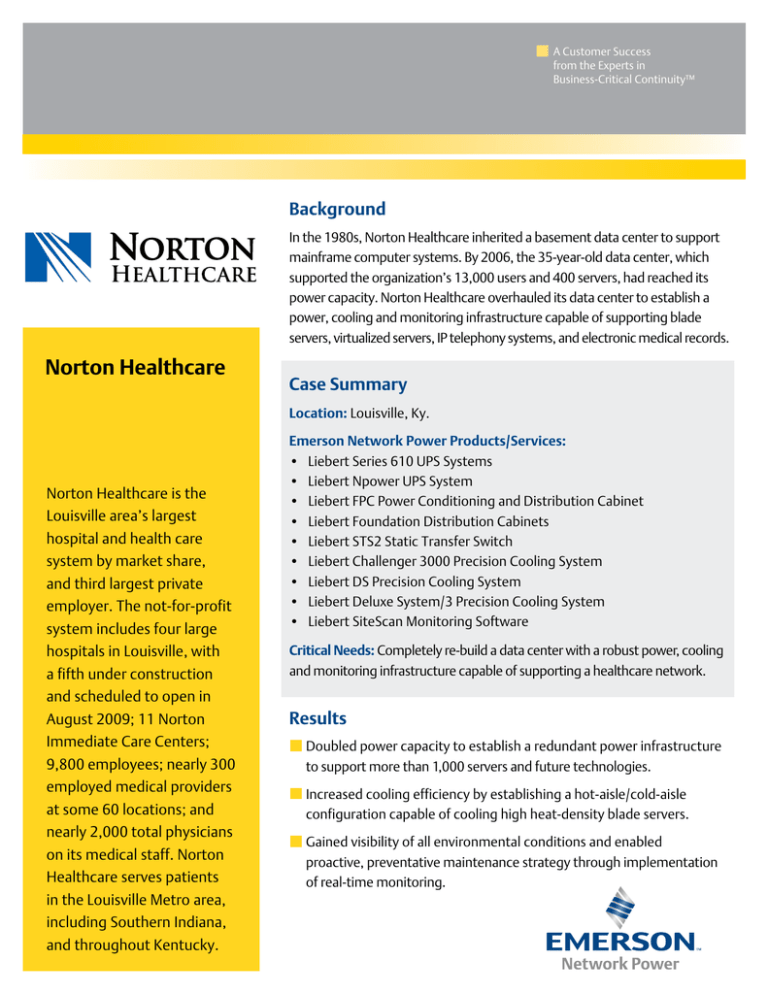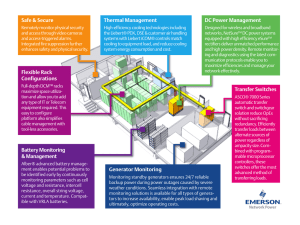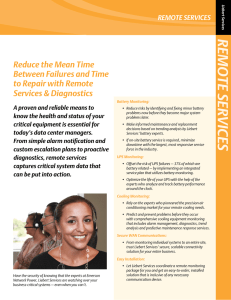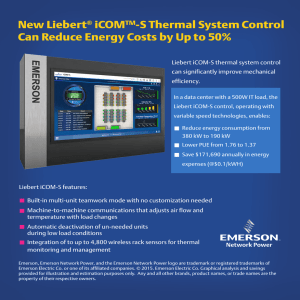
A Customer Success
from the Experts in
Business-Critical Continuity™
Background
In the 1980s, Norton Healthcare inherited a basement data center to support
mainframe computer systems. By 2006, the 35-year-old data center, which
supported the organization’s 13,000 users and 400 servers, had reached its
power capacity. Norton Healthcare overhauled its data center to establish a
power, cooling and monitoring infrastructure capable of supporting blade
servers, virtualized servers, IP telephony systems, and electronic medical records.
Norton Healthcare
Case Summary
Location: Louisville, Ky.
Norton Healthcare is the
Louisville area’s largest
hospital and health care
system by market share,
and third largest private
employer. The not-for-profit
system includes four large
hospitals in Louisville, with
a fifth under construction
and scheduled to open in
August 2009; 11 Norton
Immediate Care Centers;
9,800 employees; nearly 300
employed medical providers
at some 60 locations; and
nearly 2,000 total physicians
on its medical staff. Norton
Healthcare serves patients
in the Louisville Metro area,
including Southern Indiana,
and throughout Kentucky.
Emerson Network Power Products/Services:
• Liebert Series 610 UPS Systems • Liebert Npower UPS System
• Liebert FPC Power Conditioning and Distribution Cabinet
• Liebert Foundation Distribution Cabinets • Liebert STS2 Static Transfer Switch
• Liebert Challenger 3000 Precision Cooling System
• Liebert DS Precision Cooling System
• Liebert Deluxe System/3 Precision Cooling System
• Liebert SiteScan Monitoring Software
Critical Needs: Completely re-build a data center with a robust power, cooling
and monitoring infrastructure capable of supporting a healthcare network.
Results
Doubled power capacity to establish a redundant power infrastructure
to support more than 1,000 servers and future technologies.
Increased cooling efficiency by establishing a hot-aisle/cold-aisle
configuration capable of cooling high heat-density blade servers.
ained visibility of all environmental conditions and enabled
G
proactive, preventative maintenance strategy through implementation
of real-time monitoring.
A Customer Success
from the Experts in
Business-Critical Continuity™
The Situation
Located in the basement of a 95-year-old hotel
building, Norton Healthcare’s data center was
designed in the 1970s to support mainframe
computers. When Norton inherited the data center
in the 1980s, the facility sufficiently supported the
healthcare network’s two software applications,
but 25 years and 400 applications later, technical
planning director, Mike Moore, struggled to make the
data center meet the organization’s needs.
“Because of the mainframe technology and how
data centers were configured during the time ours
was originally built, the way things were organized
– from a client server standpoint – was not ideal for
our needs,” says Moore. Equipment sat on a wood
core floor covered by carpet. When additional cooling
capacity was needed, Moore would install a new vent
to increase air circulation. Once installed, the vents
couldn’t be moved, meaning Moore’s only option
for adding new equipment was to continuously
reconfigure the data center layout around
existing vents.
“We had rows going horizontally, others configured
perpendicular to those, and still others configured
parallel to them,” he says. “There was no hot-aisle/
cold-aisle concept here. Air was being blown in
all directions.”
The health system’s increasing need for power
capacity compounded problems. The data center,
which was now supporting the network’s four
hospitals, 10 urgent care centers and more than
60 physicians’ offices, was running more than
400 servers, including 160 virtual servers and
140 blade servers. The data center supported
13,000 users and 7,000 nodes such as printers and
faxes and IP telephony capabilities were rapidly being
added. Demand for power was high, and the power
distribution was inadequate.
Moore kept the data center running by adding new
servers and computer room air conditioning (CRAC)
units where he could. He began compiling a business
case for building out the data center’s power and
cooling infrastructure to enhance cooling efficiencies
and meet the health system’s growing power needs.
In 2006, the data center reached its maximum in
power capacity.
“We could not add another server until we addressed
our power issues,” Moore says.
The Solution
Norton Healthcare consulted with Timothy Graham,
a local Liebert Representative at Climate Conditioning
Company, Inc.
“The biggest issue facing the healthcare industry
today is the shift to digital technology,” says Graham.
“Before, if you went in for an X-ray, your doctor would
store it in one of many file cabinets, but technology
has made it possible for all of that information to
be collected digitally and stored on backup storage
devices. While this technology has enhanced the
ability to treat patients, the result is a greater load
being placed on infrastructure and an increased
dependence on IT. Your network becomes missioncritical to treating your patients.”
After consulting with Graham, Moore made the
decision to completely remodel the data center from
the slab up. Renovation of the 3,400-square-foot data
center took place in two phases. In February 2006,
A Customer Success
from the Experts in
Business-Critical Continuity™
half of the room took on the task of supporting the
network, while the other half was completely gutted
and replaced. In October 2006, operations were
transferred to the new space and the second half of
the data center was replaced. During the course of
the renovation, new electrical, data distribution, fire
suppression, cabinets, cable management, security
and monitoring capabilities were installed.
Two Liebert Series 610 UPS Systems were installed
at 400 kVA to double capacity and provide the data
center with completely redundant power. A static
switch was installed to provide a simple, reliable
response to brief overload conditions. “We installed
the second Liebert Series 610 UPS to provide dual-bus
power configuration and ensure a high-availability
infrastructure,” says Graham. “We installed the first
unit during a weekend, and removed it without any
interruption to their operations. A few weeks later,
we installed the second UPS, and since then they’ve
had true redundancy.”
Eleven Liebert computer room air conditioning units
were installed, including the Liebert Challenger 3000
Precision Cooling System, a Liebert DS Precision
Cooling System and a Liebert Deluxe System/3
Precision Cooling System. The CRAC units were
installed in a hot-aisle/cold-aisle configuration of
three rows spaced six feet apart on a new raised floor
to create cooling efficiencies not previously available
in the data center.
The data center’s Network Operations Center (NOC)
was also completely remodeled, and its operations
were enhanced through the implementation of
Before
After
“We installed the first unit during a weekend,
and removed it without any interruption to their
operations. A few weeks later, we installed the
second UPS, and since then they’ve had true
redundancy.”
Timothy Graham,
Liebert Representative at Climate Conditioning Company, Inc.
Liebert SiteScan monitoring software. Liebert SiteScan
provides the NOC with centralized monitoring and
control of SNMP devices through existing network
management systems. It also sends e-mail alerts and
local notifications when environmental conditions
or power capacities change.
A Customer Success
from the Experts in
Business-Critical Continuity™
The Results
By May 2007, the space was transformed into
an efficient, visible space supporting more than
400 business-critical applications including financial
management, scheduling, electronic health records
and medical imaging.
“Our monitoring is leaps and bounds ahead of
where it was before,” says Moore. “Liebert SiteScan
monitors all our environmentals and enables us to
perform tests and preventive maintenance on our air
handling equipment and power equipment, including
generators, UPS units and power distribution units.”
The implementation of a hot-aisle/cold-aisle rack
arrangement increased cooling efficiency. Efficiency
was gained in other ways as well, says Moore. “Just by
building the NOC and the data center the way we did,
we were able to increase our workload at least by
100 percent in the NOC without increasing staff,
and the centralized monitoring system has reduced
help desk calls by 20 percent,” he says.
Norton Healthcare now has a scalable and redundant
data center infrastructure that has already allowed for
the addition of several hundred new servers. “We’ve
configured ourselves so that we have the power that
we need in every cabinet and in every device, so if a
UPS unit experiences problems, it will be unnoticeable
to the end user,” Moore says. “We can still continue
to operate with no performance loss whatsoever.
“By building the NOC and the data center the way we
did, we were able to increase our workload at least
by 100 percent in the NOC without increasing staff,
and the centralized monitoring system has reduced
help desk calls by 20 percent.”
Mike Moore,
Technical Planning Director, Norton Healthcare
“We shouldn’t have any major considerations for
a number of years now as a result of what we did,”
continues Moore. “We may have to add CRAC units to
keep up with our server capacity, but with our current
data center, we’re good for another five years before
we’ll need to expand it.”
“Norton Healthcare now has the capacity and
redundancy to meet not only their current needs,
but future needs as well,” says Graham. “Everyone
is sleeping better at night.”
Emerson Network Power.
The global leader in enabling Business-Critical Continuity™.
EmersonNetworkPower.com
AC Power
Embedded Computing
Outside Plant
Racks & Integrated Cabinets
Connectivity
Embedded Power
Power Switching & Control
Services
DC Power
Monitoring
Precision Cooling
Surge Protection
While every precaution has been taken to ensure accuracy and completeness in this literature, Liebert Corporation assumes no responsibility, and disclaims all liability for damages
resulting from use of this information or for any errors or omissions. Specifications subject to change without notice. © 2009 Liebert Corporation. All rights reserved throughout
the world. Trademarks or registered trademarks are property of their respective owners. ® Liebert and the Liebert logo are registered trademarks of the Liebert Corporation.
Business-Critical Continuity, Emerson Network Power and the Emerson Network Power logo are trademarks and service marks of Emerson Electric Co. © 2009 Emerson Electric Co.
0109 CH-0012 (01/09)





